Search Result
Results for "
endothelial migration
" in MedChemExpress (MCE) Product Catalog:
| Cat. No. |
Product Name |
Target |
Research Areas |
Chemical Structure |
-
- HY-137967
-
|
Genistein 7-O-glucuronide
|
Others
|
Endocrinology
|
|
Genistein 7-β-D-Glucuronide is a natural product. Genistein 7-β-D-Glucuronide inhibits tubulogenesis and endothelial migration[1].
|
-
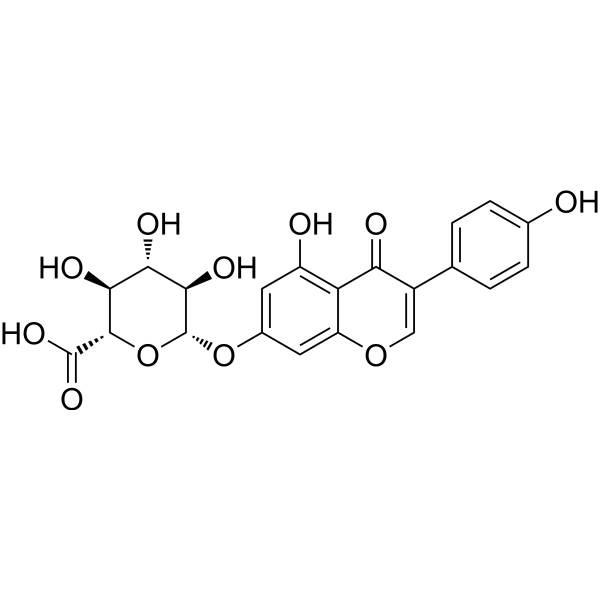
-
- HY-13813
-
Blebbistatin
Maximum Cited Publications
15 Publications Verification
|
Myosin
|
Others
|
|
Blebbistatin is a selective non-muscle myosin II (NMII) inhibitor, promotes directional migration of corneal endothelial cells (CECs) and accelerates wound healing, and better preserves cell junctional integrity and barrier function. Blebbistatin blocks cell migration .
|
-
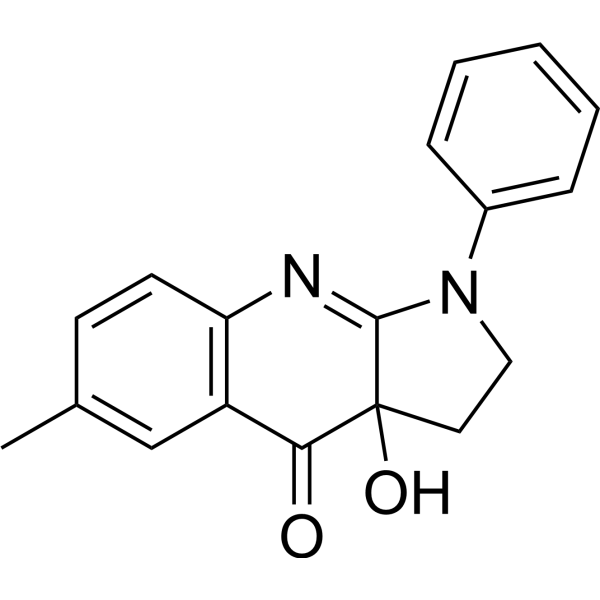
-
- HY-113434A
-
|
|
Others
|
Inflammation/Immunology
|
|
5(R)-HETE is a lipoxygenase product of arachidonic acid. 5(R)-HETE is an? inducer of neutrophil migration through endothelial and epithelial barriers. 5(R)-HETE is important in mediating lung inflammatory processes .
|
-

-
- HY-W440983
-
|
PC(18:0/22:6); DHA-PC; 1-Stearoyl-2-docosahexaenoyl-sn-glyerco-3-phosphocholine
|
PPAR
|
Cardiovascular Disease
Cancer
|
|
SDPC (DHA-PC) is a new generation of omega-3 lipids, which contains an ester bond linking DHA at the sn-2 position of phospholipid. 1-Stearoyl-2-docosahexaenoyl-sn-glyerco-3-phosphocholine exerts anti-angiogenesis effect through activating PPARγ. 1-Stearoyl-2-docosahexaenoyl-sn-glyerco-3-phosphocholine significantly declines the proliferation, migration, tube formation of human umbilical vein endothelial cells. 1-Stearoyl-2-docosahexaenoyl-sn-glyerco-3-phosphocholine has the potential for anti-tumor angiogenesis research .
|
-

-
- HY-112547
-
|
CRT0066051
|
PKD
|
Others
|
|
CRT5, a pyrazine benzamide, is a potent and selective inhibitor for all three isoforms of PKD in endothelial cells treated with VEGF (IC50s = 1, 2, and 1.5 nM for PKD1, PKD2, and PKD3, respectively). CRT5 decreases VEGF-induced endothelial migration, proliferation and tubulogenesis .
|
-
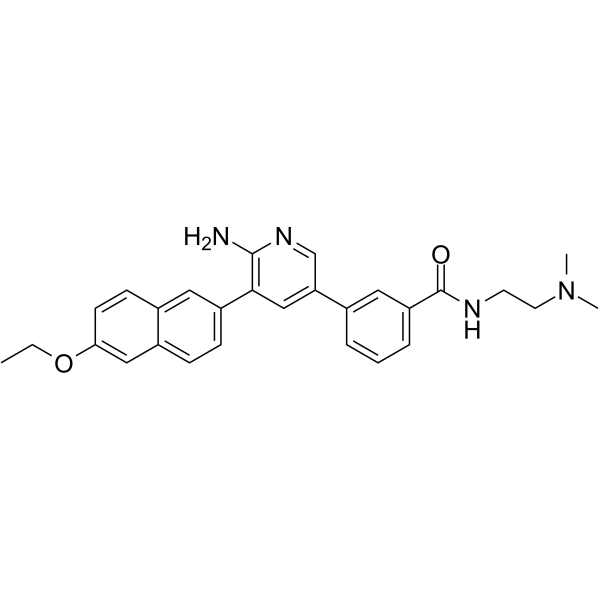
-
- HY-17369
-
|
L700462 hydrochloride monohydrate; MK383 hydrochloride monohydrate
|
Integrin
|
Cardiovascular Disease
|
|
Tirofiban (L700462) hydrochloride monohydrate is a selective and reversible platelet integrin receptor (Gp IIb/IIIa) antagonist that inhibits fibrinogen binding to this receptor and has antithrombotic activity. Tirofiban hydrochloride monohydrate induces proliferation and migration on endothelial cell by inducing production of VEGF. Tirofiban hydrochloride monohydrate can significantly reduces myocardial no-reflow and ischemia-reperfusion injury by alleviating myocardial microvascular structural and endothelial dysfunction in the ischemic area .
|
-
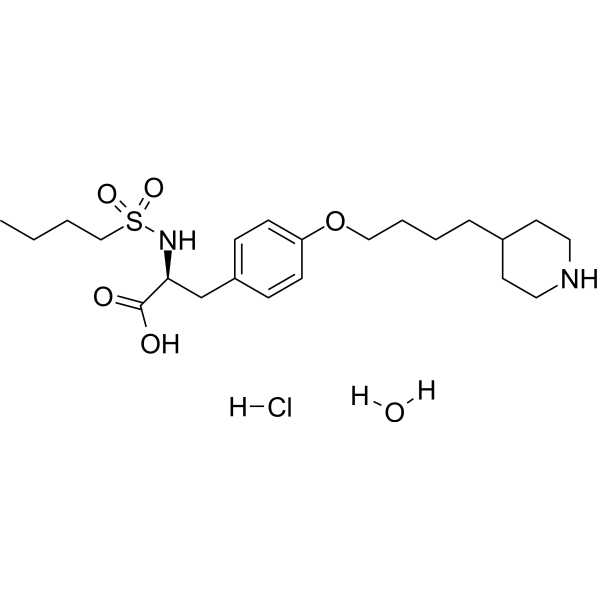
-
- HY-17369B
-
|
L700462; MK383
|
Integrin
|
Cardiovascular Disease
|
|
Tirofiban (L700462) is a selective and reversible platelet integrin receptor (Gp IIb/IIIa) antagonist that inhibits fibrinogen binding to this receptor and has antithrombotic activity. Tirofiban induces proliferation and migration on endothelial cell by inducing production of VEGF. Tirofiban can significantly reduces myocardial no-reflow and ischemia-reperfusion injury by alleviating myocardial microvascular structural and endothelial dysfunction in the ischemic area .
|
-

-
- HY-17369A
-
|
L700462 hydrochloride; MK383 hydrochloride
|
Integrin
|
Cardiovascular Disease
|
|
Tirofiban (L700462) hydrochloride is a selective and reversible platelet integrin receptor (Gp IIb/IIIa) antagonist that inhibits fibrinogen binding to this receptor and has antithrombotic activity. Tirofiban hydrochloride induces proliferation and migration on endothelial cell by inducing production of VEGF. Tirofiban hydrochloride can significantly reduces myocardial no-reflow and ischemia-reperfusion injury by alleviating myocardial microvascular structural and endothelial dysfunction in the ischemic area .
|
-
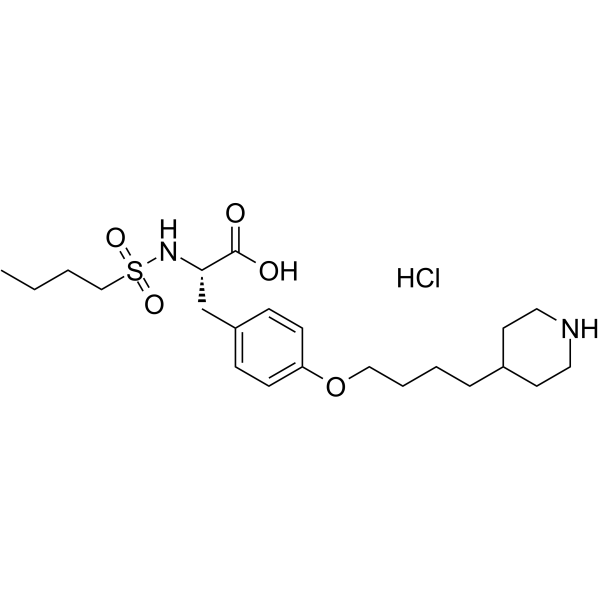
-
- HY-P99516
-
|
HLX-06
|
VEGFR
|
Cancer
|
|
Vulinacimab (HLX-06) is an anti-VEGFR-2 monoclonal antibody (mAb). Vulinacimab can be used in the research of cancers. VEGFR-2, overexpressed in certain tumors, is critical in angiogenesis and the proliferation, survival, migration and differentiation of endothelial cells .
|
-

-
- HY-P3695
-
|
|
FGFR
|
Cancer
|
|
VSPPLTLGQLLS is a small peptide FGFR3 inhibitor, peptide P3, inhibits FGFR3 phosphorylation. VSPPLTLGQLLS inhibits 9-cisRA-induced tracheal lymphangiogenesis and blocks lymphatic endothelial cell (LEC) proliferation, migration, and tubule formation .
|
-

-
- HY-112234
-
|
Sepiapterin
|
Endogenous Metabolite
|
Cancer
|
|
L-Sepiapterin (Sepiapterin) is a precursor of the endothelial nitric oxide synthase (eNOS) cofactor tetrahydrobiopterin (BH4). L-Sepiapterin improves endothelial dysfunction in small mesenteric arteries from db/db mice, and induces angiogenesis. L-Sepiapterin inhibits cell proliferation and migration of ovarian cancer cells via down-regulation of p70 S6K-dependent VEGFR-2 expression .
|
-

-
- HY-P3695A
-
|
|
FGFR
|
Cancer
|
|
VSPPLTLGQLLS TFA is a small peptide FGFR3 inhibitor, peptide P3, inhibits FGFR3 phosphorylation. VSPPLTLGQLLS TFA inhibits 9-cisRA-induced tracheal lymphangiogenesis and blocks lymphatic endothelial cell (LEC) proliferation, migration, and tubule formation .
|
-

-
- HY-161400
-
|
|
TGF-β Receptor
|
Cancer
|
|
TGFβRII-IN-2 (Compound 3n) is an inhibitor for transforming growth factor-β type II receptor (TGFβRII) with IC50 of 2.4 μM, which blocks endothelial-to-mesenchymal transition and cell migration in different cancer cell lines without perturbing the microtubule network .
|
-

-
- HY-149921
-
|
|
Others
|
Cancer
|
|
Antiangiogenic agent 3 (compound 3) is a potent antiangiogenic agent. Antiangiogenic agent 3 is an inhibitor of human umbilical vein endothelial cells (HUVEC). Antiangiogenic agent 3 inhibits HUVEC migration and chemotactic motilities. Antiangiogenic agent 3 also decreases the gene expression of Src, cdc42, and MAPK .
|
-

-
- HY-120200
-
|
|
VEGFR
|
Cardiovascular Disease
Cancer
|
|
YF-452 is a potent inhibitor of vascular endothelial growth factor receptor 2 (VEGFR2). YF-452 remarkably inhibits the migration, invasion and tube-like structure formation of human umbilical vein endothelial cells (HUVECs) with little toxicity. YF-452 inhibits VEGF-induced phosphorylation of VEGFR2 kinase and the downstream protein kinases including extracellular signal regulated kinase (ERK), focal adhesion kinase (FAK) and Src. YF-452 is a potential antiangiogenic agent candidate for cancer research .
|
-

-
- HY-P4002
-
|
|
ADAMTS
|
Cancer
|
|
Adamtsostatin 18 is an anti-angiogenic peptide derived from proteins containing type I thrombospondin motifs. Adamtsostatin 18 inhibits cell migration and proliferation .
|
-

-
- HY-N2132
-
|
Flavokavain B
|
Apoptosis
|
Cancer
|
|
Flavokawain B (Flavokavain B) is a chalcone isolated from the root extracts of kava-kava plant and a potent apoptosis inducer for inhibiting the growth of various cancer cell lines. Flavokawain B (Flavokavain B) shows strong antiangiogenic activity. Flavokawain B (Flavokavain B) inhibits human brain endothelial cell (HUVEC) migration and tube formation with very low and non-toxic concentrations .
|
-
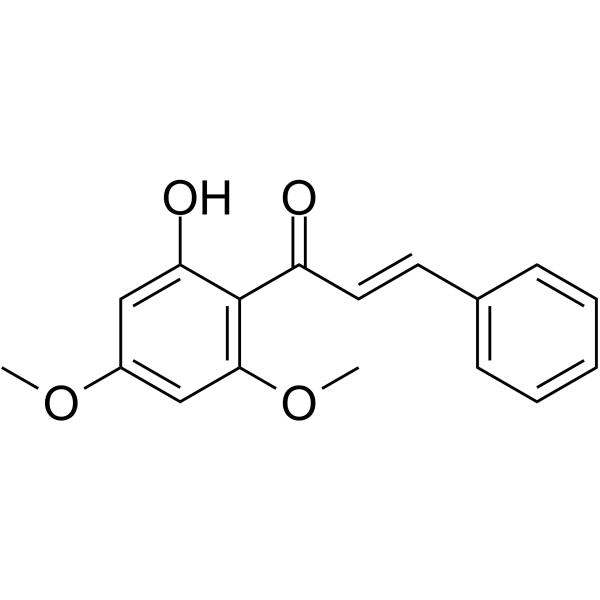
-
- HY-P3571
-
|
|
Endothelin Receptor
|
Cancer
|
|
[Ala2] Endothelin-3, human is a linear analog of endothelin-3 (ET-3) where substitution of Ala for Cys residues. TE-3 is a vasoactive peptide, produced by human rhabdomyosarcoma cell lines, whereas it is not expressed by human sarcoma cell lines of non-muscle origin. ET-3 acts as a paracrine factor, since it promotes migration of endothelial cells .
|
-
![[Ala2] Endothelin-3, human](//file.medchemexpress.com/product_pic/hy-p3571.gif)
-
- HY-132305
-
|
|
VEGFR
|
Cancer
|
|
VEGFR-3-IN-1 is a potent and selective VEGFR3 inhibitor with an IC50 of 110.4 nM. VEGFR-3-IN-1 significantly inhibits proliferation and migration of VEGF-C-induced human dermal lymphatic endothelial cells (HDLEC), MDA-MB-231, and MDA-MB-436 cells by inactivating the VEGFR3 signaling pathway, and also effectively inhibits breast cancer growth .
|
-

-
- HY-133924
-
|
RQN-18690A
|
Others
|
Cardiovascular Disease
Cancer
|
|
18-Deoxyherboxidiene (RQN-18690A) is a potent angiogenesis inhibitor. 18-Deoxyherboxidiene targets SF3b, a spliceosome component that is a subcomplex of the U2 small nuclear ribonucleoprotein (snRNP) in the spliceosome. 18-Deoxyherboxidiene inhibits the migration and tube formation of human umbilical vein endothelial cells (HUVECs) without significant cell toxicity. 18-Deoxyherboxidiene has the potential for cancer research .
|
-

-
- HY-N2692
-
|
|
Others
|
Cancer
|
|
6,8-Diprenylgenistein is an isoflavone compound isolated from Cudrania tricuspidata. 6,8-Diprenylgenistein has antimicrobial and anti-obesity activity. 6,8-Diprenylgenistein inhibits the proliferation, migration and tubular formation of HLMEC induced by recombinant human vascular endothelial growth factor-A. 6,8-Diprenylgenistein can be used to study new therapeutic drugs for the prevention and treatment of oral cancer metastasis .
|
-
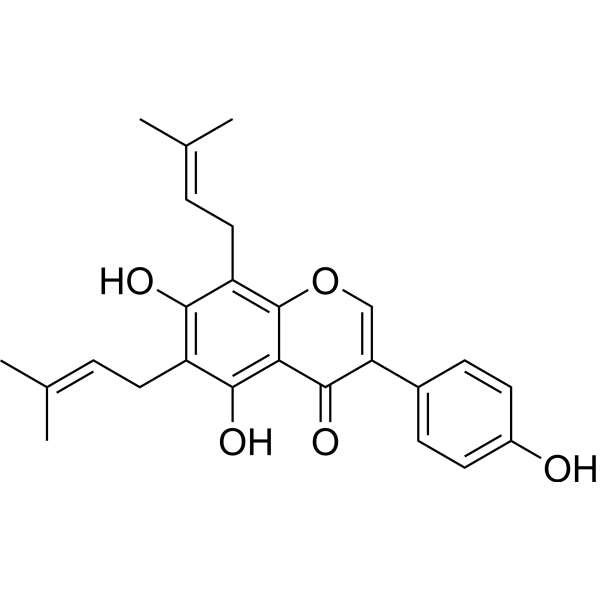
-
- HY-161398
-
|
|
TGF-β Receptor
TGF-beta/Smad
|
Cancer
|
|
TGFβRI-IN-7 (Compound 2r) is a selective inhibitor of the TGFβ type II receptor (TGFβ RII) (IC50 = 4.1 μM). TGFβRI-IN-7 inhibits TGFβ signaling by promoting the proteolytic degradation of TGFβ RII. TGFβRI-IN-7 can block endothelial-to-mesenchymal transition and cell migration. TGFβRI-IN-7 can be used in cancer research .
|
-

-
- HY-P1435A
-
|
|
NADPH Oxidase
|
Cancer
|
|
NoxA1ds TFA is a potent and selective NADPH oxidase 1 (NOX1) inhibitor (IC50=20 nM). NoxA1ds TFA exhibits selectivity for NOX1 over NOX2, NOX4, NOX5 and xanthine oxidase. NoxA1ds TFA inhibits NOX1-derived O2- production in HT-29 human colon cancer cells. NoxA1ds TFA attenuates VEGF-induced human pulmonary artery endothelial cell migration under hypoxic conditions in vitro.
|
-

-
- HY-148877
-
|
|
HSP
HSV
HIF/HIF Prolyl-Hydroxylase
VEGFR
NF-κB
ERK
Akt
FAK
|
Infection
Inflammation/Immunology
Cancer
|
|
AT-533 is a potent Hsp90 and HSV inhibitor. AT-533 suppresses tumor growth and angiogenesis by blocking the HIF-1α/VEGF/VEGFR-2 signaling pathway. AT-533 also inhibits the activation of the downstream pathways, including Akt/mTOR/p70S6K, Erk1/2 and FAK. AT-533 inhibits the tube formation, cell migration, and invasion of human umbilical vein endothelial cells (HUVECs) .
|
-

-
- HY-160850
-
|
|
Others
|
Endocrinology
|
|
C18 Ceramide-1-phosphate (d18:1/18:0) (ammonium salt) is a specific type of long-chain molecule found in murine skin . C18 Ceramide-1-phosphate (d18:1/18:0) (ammonium salt) promotes migration of both mouse bone marrow-derived multipotent stromal cells and human umbilical vein endothelial cells at concentrations between 0.5-5 µM. C18 Ceramide-1-phosphate (d18:1/18:0) (ammonium salt)’s levels are higher in CFPAC-1 pancreatic ductal adenocarcinoma cells than in pancreatic cancer stem cells .
|
-
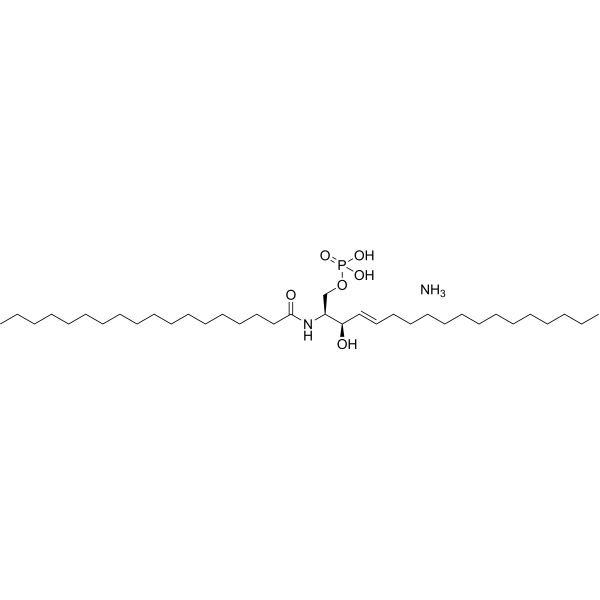
-
- HY-P5380
-
|
Dabcyl-GABA-Pro-Gln-Gly-Leu-Glu(EDANS)-Ala-Lys-NH2
|
MMP
|
Others
|
|
TNO211 is a biological active peptide. (Matrix Metalloproteinases (MMPs) are a large family of endopeptidases. Collectively, MMPs can degrade all kinds of extracellular matrix proteins, and can also process a number of bioactive molecules. They are known to be involved in the cleavage of cell surface receptors, the release of apoptotic ligands, and chemokine/cytokine inactivation. MMPs are also thought to play a major role in cell behaviors such as cell proliferation, migration (adhesion/dispersion), differentiation, angiogenesis, apoptosis, and host defense.This peptide is a highly soluble fluorogenic MMP substrate for MMP-2, 8, 12, 13 and 14, containing the MMP cleavable Gly-Leu bond and EDANS/DABCYL. Fluorogenic assays using TNO211 are sensitive and can detect MMP activity in culture medium from endothelial cells and untreated synovial fluid from patients. Abs/Em = 340/490 nm.)
|
-

-
- HY-113116
-
|
D-erythro-Dihydrosphingosine 1-phosphate
|
Endogenous Metabolite
|
Inflammation/Immunology
Cancer
|
|
Sphinganine 1-phosphate (D-erythro-Dihydrosphingosine 1-phosphate) is a polar sphingolipid metabolite that regulates cell migration, differentiation, survival and complex physiological processes .
|
-

| Cat. No. |
Product Name |
Target |
Research Area |
-
- HY-P0170
-
TB500
1 Publications Verification
|
Peptides
|
Metabolic Disease
|
|
TB500 is a synthetic version of an active region of thymosin β4. TB500 is claimed to promote endothelial cell differentiation, angiogenesis in dermal tissues, keratinocyte migration, collagen deposition and decrease inflammation .
|
-
- HY-P3695
-
|
|
FGFR
|
Cancer
|
|
VSPPLTLGQLLS is a small peptide FGFR3 inhibitor, peptide P3, inhibits FGFR3 phosphorylation. VSPPLTLGQLLS inhibits 9-cisRA-induced tracheal lymphangiogenesis and blocks lymphatic endothelial cell (LEC) proliferation, migration, and tubule formation .
|
-
- HY-P3995
-
|
|
Peptides
|
Cardiovascular Disease
|
|
Scospondistatin is an anti-angiogenic peptide that can inhibit proliferation and migration of human umbilical vein endothelial cells in vitro .
|
-
- HY-P3999
-
|
|
Peptides
|
Cardiovascular Disease
|
|
Fibulostatin 6.2 is an anti-angiogenic peptide that can inhibit migration of human umbilical vein endothelial cells in vitro .
|
-
- HY-P3695A
-
|
|
FGFR
|
Cancer
|
|
VSPPLTLGQLLS TFA is a small peptide FGFR3 inhibitor, peptide P3, inhibits FGFR3 phosphorylation. VSPPLTLGQLLS TFA inhibits 9-cisRA-induced tracheal lymphangiogenesis and blocks lymphatic endothelial cell (LEC) proliferation, migration, and tubule formation .
|
-
- HY-P4002
-
|
|
ADAMTS
|
Cancer
|
|
Adamtsostatin 18 is an anti-angiogenic peptide derived from proteins containing type I thrombospondin motifs. Adamtsostatin 18 inhibits cell migration and proliferation .
|
-
- HY-P0306
-
|
Heparin Binding Peptide
|
Peptides
|
Cardiovascular Disease
|
|
Fibronectin Adhesion-promoting Peptide (Heparin Binding Peptide) is one of the heparin-binding amino acid sequences found in the carboxy-terminal heparin-binding domain of fibronectin. It promotes assembly of mesenchymal stem cell (MSC) spheroids into larger aggregates. Fibronectin Adhesion-promoting Peptide directly promotes the adhesion, spreading, and migration of endothelial cells by reacting with heparin binding domains of cells .
|
-
- HY-P0306A
-
|
Heparin Binding Peptide TFA
|
Peptides
|
Cardiovascular Disease
|
|
Fibronectin Adhesion-promoting Peptide (Heparin Binding Peptide) is one of the heparin-binding amino acid sequences found in the carboxy-terminal heparin-binding domain of fibronectin. It promotes assembly of mesenchymal stem cell (MSC) spheroids into larger aggregates. Fibronectin Adhesion-promoting Peptide directly promotes the adhesion, spreading, and migration of endothelial cells by reacting with heparin binding domains of cells .
|
-
- HY-P3571
-
|
|
Endothelin Receptor
|
Cancer
|
|
[Ala2] Endothelin-3, human is a linear analog of endothelin-3 (ET-3) where substitution of Ala for Cys residues. TE-3 is a vasoactive peptide, produced by human rhabdomyosarcoma cell lines, whereas it is not expressed by human sarcoma cell lines of non-muscle origin. ET-3 acts as a paracrine factor, since it promotes migration of endothelial cells .
|
-
- HY-P1435A
-
|
|
NADPH Oxidase
|
Cancer
|
|
NoxA1ds TFA is a potent and selective NADPH oxidase 1 (NOX1) inhibitor (IC50=20 nM). NoxA1ds TFA exhibits selectivity for NOX1 over NOX2, NOX4, NOX5 and xanthine oxidase. NoxA1ds TFA inhibits NOX1-derived O2- production in HT-29 human colon cancer cells. NoxA1ds TFA attenuates VEGF-induced human pulmonary artery endothelial cell migration under hypoxic conditions in vitro.
|
-
- HY-P5380
-
|
Dabcyl-GABA-Pro-Gln-Gly-Leu-Glu(EDANS)-Ala-Lys-NH2
|
MMP
|
Others
|
|
TNO211 is a biological active peptide. (Matrix Metalloproteinases (MMPs) are a large family of endopeptidases. Collectively, MMPs can degrade all kinds of extracellular matrix proteins, and can also process a number of bioactive molecules. They are known to be involved in the cleavage of cell surface receptors, the release of apoptotic ligands, and chemokine/cytokine inactivation. MMPs are also thought to play a major role in cell behaviors such as cell proliferation, migration (adhesion/dispersion), differentiation, angiogenesis, apoptosis, and host defense.This peptide is a highly soluble fluorogenic MMP substrate for MMP-2, 8, 12, 13 and 14, containing the MMP cleavable Gly-Leu bond and EDANS/DABCYL. Fluorogenic assays using TNO211 are sensitive and can detect MMP activity in culture medium from endothelial cells and untreated synovial fluid from patients. Abs/Em = 340/490 nm.)
|
| Cat. No. |
Product Name |
Target |
Research Area |
-
- HY-P99516
-
|
HLX-06
|
VEGFR
|
Cancer
|
|
Vulinacimab (HLX-06) is an anti-VEGFR-2 monoclonal antibody (mAb). Vulinacimab can be used in the research of cancers. VEGFR-2, overexpressed in certain tumors, is critical in angiogenesis and the proliferation, survival, migration and differentiation of endothelial cells .
|
| Cat. No. |
Product Name |
Category |
Target |
Chemical Structure |
Your information is safe with us. * Required Fields.
Inquiry Information
- Product Name:
- Cat. No.:
- Quantity:
- MCE Japan Authorized Agent:























![[Ala2] Endothelin-3, human](http://file.medchemexpress.com/product_pic/hy-p3571.gif)











